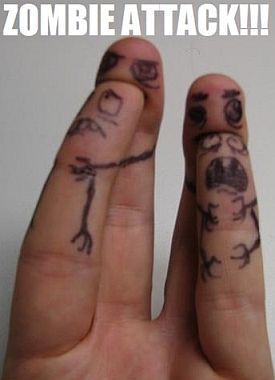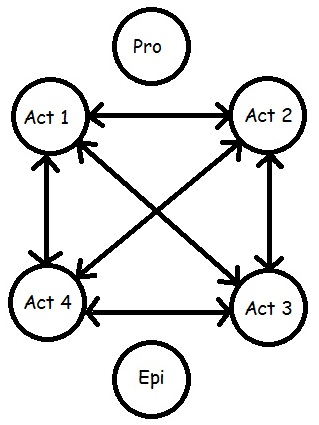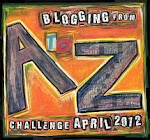 Before I continue with my zombie brainstorms, I realized I made a boo-boo of sorts. GFYG! doesn’t grant a new Hit Die at every level, but only for the first 4 levels. For example, the brave character class grants a d10 Hit Die at each level 1 through 4 only. After that, the brave gets +3 hit points per level thereafter.
Before I continue with my zombie brainstorms, I realized I made a boo-boo of sorts. GFYG! doesn’t grant a new Hit Die at every level, but only for the first 4 levels. For example, the brave character class grants a d10 Hit Die at each level 1 through 4 only. After that, the brave gets +3 hit points per level thereafter.
The proposed Bruises/Wounds system in the last post will still work with one clarification. The bonus hit points gained by a character after 4th level are added to Bruises only.
Classes
GFYG! has 11 classes, including the optional wandering monk. The other 10 classes are the brave, doctor, drifter, gunslinger, maverick, mountain man, muckraker, preacher, scout, and wrangler. Many of these classes look like they’d work without modifications in a survival horror game. There are some questionable cases, however.
Doctor: Can a doctor treat an infected via his herbals class ability? It seems the answer must be, “No.” Part of the horror is that the infected cannot be cured. It does seem fair, however, that a doctor might be able to help an exposed person resist initial infection. Thus, we need an addendum to Herbals.
Herbals Addendum: A doctor cannot cure an infected. If, however, he acts quickly once a person is exposed, he does grant his Herbals save bonus to the victim. To do this, the doctor must take an action before the end of the round after the victim is exposed. After that, it is too late to apply medical countermeasures.
Another doctor ability, Pain Relief Potion, mentions negating “the effects of negative modifiers on attribute checks and attack rolls from painful wounds.” I don’t see any mention of such modifiers in GFYG!. Do they need to be clarified? Maybe, maybe not.
Care & Attention, Heal, and Minor Surgery also need some tweaking due to the change in hit points. Treat all references to hit points as applicable to Wounds. Bruises are restored at twice the rate of Wounds (although for Care & Attention this won’t matter much).
Drifter: The drifter’s Prairie Tales ability applies to “zombie” lore as well.
Maverick & Muckraker: The Silvertongue ability cannot be used to “strike up friendships” with the infected. A maverick can use Showmanship against the infected, but the maximum duration is halved. The muckraker’s Prairie Tales ability applies to “zombie” lore. These classes’ other abilities work as normal.
Preacher: A preacher cannot Exalt or Demoralize the infected. He cannot Exhort Greatness in an infected. His Sanctuary ability works against the infected, but the preacher suffers a -2 penalty to his attribute check. His General Knowledge applies to “zombie” lore. Like the doctor, the preacher’s first aid restores Wounds and twice as many Bruises. The preacher’s other abilities are unchanged.
Wandering Monk: A wandering monk’s Stunning Attack works against the infected, but the duration is halved. The monk’s Fast Healing restores Wounds and twice that number of Bruises. Otherwise, the wandering monk is unchanged.
Brave, Gunslinger, Mountain Man, Scout, & Wrangler: These classes work as normal.
Exploding Dice
Every GFYG! hero has two primary attributes, two secondary attributes, and two tertiary attributes. One of the hero’s primary attributes is determined by class. For example, a scout’s primary attributes always include Dexterity. Each attribute has a particular exploding die assigned to it.
But wait, you say. What are exploding dice? That sounds dangerous!
Well, that’s kind of the point. Let’s say your exploding die is a d4. When you roll it, if it comes up a 4, you roll again and add the two rolls. If another 4 comes up, you roll again, et cetera.
For example, Tex makes a Wisdom check, rolling 1d20 plus 1d4 against a target number of 18 (since Wisdom is one of his tertiary attributes). He rolls a 9 on the d20, and a 4 on the d4. He rerolls the latter die and gets another 4. He rolls again, scoring a 2. His total roll is 9 + 4 + 4 + 2, or 19 (not counting any applicable Wisdom modifier). Tex makes his Wisdom check!
Now, back to the types of exploding dice that go with a hero’s attributes:
Primary Attribute: d8
Secondary Attribute: d6
Tertiary Attribute: d4
Exploding dice also apply to attack rolls. Any hero who has a +1 Bonus to Hit at 1st level uses a d6 exploding die with attack rolls. Other heroes use a d4.
But why? Why use exploding dice in survival horror?
Good question. The main reason is that the odds of surviving long are stacked against the heroes. The infected are seriously dangerous. One failed Constitution check against infection is a death sentence. The exploding dice reflect that special element of luck that many characters in survival horror movies seem to enjoy.
But, as Brendan Gleeson’s character Frank in 28 Days Later demonstrated, even a hero’s luck runs out eventually, and exploding dice can help simulate that as well.
If a hero both fails an attribute check or attack roll and his exploding die yields its lowest possible result, the hero’s luck has run out. For the rest of the game day, the hero doesn’t get to use his exploding dice.
For example, Tex swings his machete at an infected, rolling 1d20 and 1d6. He rolls a 5 on the d20 and a 1 on the d6. He not only fails the attack, but his luck has run out. As more infected rush through the shattered saloon windows, Tex’s situation looks grim. He can still attack, but he doesn’t get to use his exploding dice for anything.
Back to Survival of the Fittest
Even with the distinction between Bruises and Wounds and the addition of exploding dice, hero death is all but inevitable in survival horror. As Tex demostrates above, when a hero’s luck runs out, he can find himself going from frying pan into fire. This means players are probably going to end up making up new heroes.
A new hero comes into the game at the same level as the player’s recently deceased hero. What’s more, the player doesn’t have to roll 3d6 for all six attributes. Instead, he rolls 3d6 five times, and gets a sixth score equal to either 15 or his last character’s highest ability score, whichever is higher. The player can then arrange these attributes to taste.
For example, Tex is eaten. His attributes were Strength 13, Dexterity 17, Constitution 14, Intelligence 5, Wisdom 10, Charisma 11. (Tex was as a dull as a loaf of bread.) Tex’s player gets to keep the 17. He rolls 3d6 five times, getting these results: 14, 11, 13, 10, and 6. Tex’s player decides his new character will be a mountain man with a 17 Constitution.
Next up, I think I’m going to shift away from game mechanics and look at the history of the infection. Where did it come from? Who has done what in response? When did the plague start?
Tags: adventure design, game play, horror
 Who says teachers get the summer off?
Who says teachers get the summer off? Before I continue with my zombie brainstorms, I realized I made a boo-boo of sorts. GFYG! doesn’t grant a new Hit Die at every level, but only for the first 4 levels. For example, the brave character class grants a d10 Hit Die at each level 1 through 4 only. After that, the brave gets +3 hit points per level thereafter.
Before I continue with my zombie brainstorms, I realized I made a boo-boo of sorts. GFYG! doesn’t grant a new Hit Die at every level, but only for the first 4 levels. For example, the brave character class grants a d10 Hit Die at each level 1 through 4 only. After that, the brave gets +3 hit points per level thereafter.



